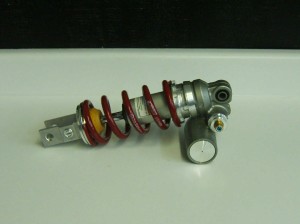I met Kevin, the owner of this shock at a MotoYard.com track day.┬Ā Kevin has a popular aftermarket shock on his ŌĆś08 R-6.┬Ā I adjusted that shock to do itŌĆÖs best but a weak spring with too much pre-load even with the adjuster backed off all the way and very little compression damping limits what I can do at the track.
Kevin was surprised when I told him that his stock shock is better than most aftermarket shocks and that I could make it perfect.
$420 to rebuild, re-valve and re-spring this shock.┬Ā I start with the correct rate spring for your weight, not the correct rate according to your buddy.┬Ā Then I add the correct amount of pre-load, again I use Jim LindemannŌĆÖs system here not what some guy on the internet said.┬Ā Then I fix the high speed compression adjuster so it has a useful range.┬Ā Then I change the valve stacks to get any damping curve I want.
The best thing about these R-6 shocks is the high speed compression adjuster.┬Ā ItŌĆÖs the same as on the R-6 forks.┬Ā After I fix the range of adjustment you have a stock shock (and forks) that have a working high speed compression adjuster.┬Ā Being able to change the high speed damping is almost as good as re-valving and you can do it with a wrench!
High speed damping comes into play when the forks or shock move fast like on a bump.┬Ā Low speed damping is for when they move slow like leaning into a turn.
Kevin and I will install this shock back on his bike this Friday afternoon at Streets of Willow and he will race with it on Friday with Moto West GP.
Sure I could re-spring and re-valve his aftermarket shock but even then it would not have a high speed compression adjuster.
Some aftermarket shocks are great.┬Ā Penske builds their shocks to order using the correct rate springs and they have good damping curves.


